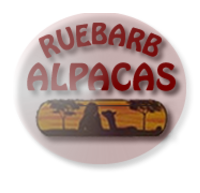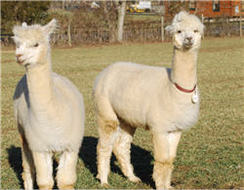Frequently Asked Questions
We find that most people researching alpacas want to know about the same things, so we have put together a list of the most frequently asked questions.
Are alpacas easy to look after?
Yes! They require plenty of good quality hay available at all times, as well as fresh water. Depending on what area of the country you live in, you may need to worm them every month, at least in the summertime, and they need their nails clipping every few months, unless they are running on hard ground.
Once a year they need to be sheared - most people hire a professional to do that.
What do they eat?
They eat hay (preferably second cut Orchard grass), and fresh grazing if it is available. It is important to avoid fescue and rye grass in pasture areas as these can cause health problems. In some states they are kept on dry lot, so hay is their only food.
Other than that, some people feed them supplements, but these are not really necessary unless the alpacas are nursing.
How much land do you need to keep alpacas?
That depends on the type and quality of the land. The general rule of thumb is to keep between 5 and 8 alpacas per acre, assuming that the acre is all good quality grassland. If the land is rocky, or the grass is poor quality, it will support fewer alpacas.
How big do they get?
Male alpacas typically grow to about 36 to 40 inches at the shoulder, and weigh 160 to 200 lbs. Females are usually a little smaller, perhaps 150 to 180 lbs. Of course, some are bigger than the average and some are smaller.
How often do you shear them?
They are sheared once a year, usually about May, but that depends on whereabouts in the country they are living. If it is very hot they could be sheared in April and if they are right up in the north they may be left until early June. It can't be left too late as they need time to grow a substantial fleece back by wintertime.
What do you do with the wool?
When the alpaca is sheared, the fleece (wool) is separated into three types: the blanket (the best), seconds (from the neck and upper leg areas) and thirds (the rest). The blanket is usually sold or made up into top quality products. Seconds and thirds may be made into coarser products such as rugs or blankets.
Do alpacas spit?
Yes, they do spit, but usually at each other rather than at humans. Spitting is usually reserved for the occasional fights over food, or boys challenging each other for the position of alpha male.
Where do they come from?
Alpacas originated in South America and the largest populations are still in Peru, Chile and Bolivia.
How much do they cost?
The answer is "as much (or as little) as you want to pay"! Alpacas are available for a few hundred dollars for a fiber male up to hundreds of thousands for a world class herdsire.
Most females cost between about $6,000 and $25,000, depending on factors such as their heritage, age, color and temperament.
Why are they so expensive?
The price reflects the normal economic pressures of supply and demand. As no further imports are allowed, the supply is limited to the reproduction rate of the North American herd. With this limited supply source, and an ever-growing demand for alpacas the prices remain high.
Will the high prices last?
Since the terrorist attack on 9/11, more and more people are interested in living a simpler lifestyle and moving to a rural community. Alpacas provide an ideal way to do that and have a income to support life in the country.
Who buys alpacas?
All kinds of people - children for 4H projects, young couples wanting to start life on a farm, home-schoolers wanting and extra income, handspinners for the fiber, retired folk wanting to supplement their pensions...the list is endless. Alpacas truly offer something for everybody.
We hope that these comments have answered some of your questions about alpacas, but if you have other questions or comments, please get in touch with us at Ruebarb Alpacas.
Are alpacas easy to look after?
Yes! They require plenty of good quality hay available at all times, as well as fresh water. Depending on what area of the country you live in, you may need to worm them every month, at least in the summertime, and they need their nails clipping every few months, unless they are running on hard ground.
Once a year they need to be sheared - most people hire a professional to do that.
What do they eat?
They eat hay (preferably second cut Orchard grass), and fresh grazing if it is available. It is important to avoid fescue and rye grass in pasture areas as these can cause health problems. In some states they are kept on dry lot, so hay is their only food.
Other than that, some people feed them supplements, but these are not really necessary unless the alpacas are nursing.
How much land do you need to keep alpacas?
That depends on the type and quality of the land. The general rule of thumb is to keep between 5 and 8 alpacas per acre, assuming that the acre is all good quality grassland. If the land is rocky, or the grass is poor quality, it will support fewer alpacas.
How big do they get?
Male alpacas typically grow to about 36 to 40 inches at the shoulder, and weigh 160 to 200 lbs. Females are usually a little smaller, perhaps 150 to 180 lbs. Of course, some are bigger than the average and some are smaller.
How often do you shear them?
They are sheared once a year, usually about May, but that depends on whereabouts in the country they are living. If it is very hot they could be sheared in April and if they are right up in the north they may be left until early June. It can't be left too late as they need time to grow a substantial fleece back by wintertime.
What do you do with the wool?
When the alpaca is sheared, the fleece (wool) is separated into three types: the blanket (the best), seconds (from the neck and upper leg areas) and thirds (the rest). The blanket is usually sold or made up into top quality products. Seconds and thirds may be made into coarser products such as rugs or blankets.
Do alpacas spit?
Yes, they do spit, but usually at each other rather than at humans. Spitting is usually reserved for the occasional fights over food, or boys challenging each other for the position of alpha male.
Where do they come from?
Alpacas originated in South America and the largest populations are still in Peru, Chile and Bolivia.
How much do they cost?
The answer is "as much (or as little) as you want to pay"! Alpacas are available for a few hundred dollars for a fiber male up to hundreds of thousands for a world class herdsire.
Most females cost between about $6,000 and $25,000, depending on factors such as their heritage, age, color and temperament.
Why are they so expensive?
The price reflects the normal economic pressures of supply and demand. As no further imports are allowed, the supply is limited to the reproduction rate of the North American herd. With this limited supply source, and an ever-growing demand for alpacas the prices remain high.
Will the high prices last?
Since the terrorist attack on 9/11, more and more people are interested in living a simpler lifestyle and moving to a rural community. Alpacas provide an ideal way to do that and have a income to support life in the country.
Who buys alpacas?
All kinds of people - children for 4H projects, young couples wanting to start life on a farm, home-schoolers wanting and extra income, handspinners for the fiber, retired folk wanting to supplement their pensions...the list is endless. Alpacas truly offer something for everybody.
We hope that these comments have answered some of your questions about alpacas, but if you have other questions or comments, please get in touch with us at Ruebarb Alpacas.
Friday, July 28, 2017


